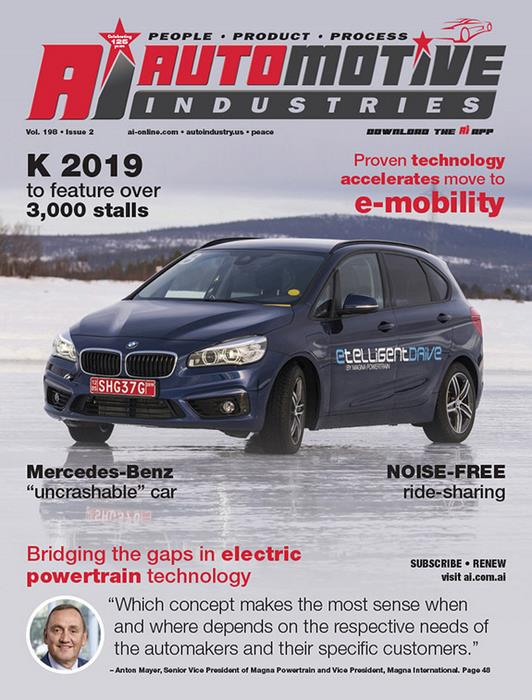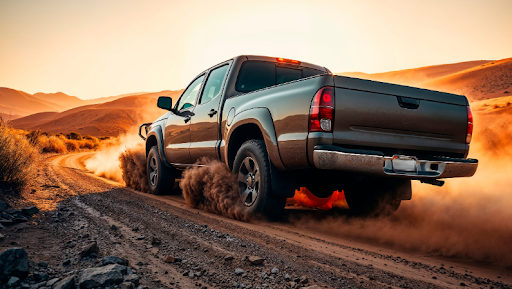
There are at least 42 possible electric powertrain architectures, according to powertrain supplier Magna. “Even though the mobility needs of customers are becoming increasingly individualized, we have noticed clear trends leaning towards heightened safety, increased flexibility, added automation and stronger mobile service connectivity.
There is no one customer of tomorrow.
All OEMs and end consumers define their individual needs depending on the regional market,” says the company. The company’s modular systems (or scalable building blocks) which support 29 of the architectures were put to the test at its annual Magna Wintertest day.
The highlight at Magna Wintertest ’19 was the premiere of the e2 prototype vehicle, which represents the entire range of electrification in one vehicle. Historically, vehicle performance has been determined by scalable internal combustion engines. “But now, by integrating electrified systems with scalable building blocks like e-machines or inverters, Magna is able to deliver a revolutionary concept.
While reducing the number of ICE variants at the same time. This approach allows automotive manufacturers to retain their variety of vehicle configurations due to the fact that our building blocks can be scaled to fit any vehicle segment,” says the company. A frozen test track in northern Sweden is used by Magna to test its prototypes and current production vehicles using Magna’s advanced propulsion technologies systems – including full-electric, high-voltage and mild-hybrids with 48-volt technology. The testing takes place under demanding climatic and driving conditions, challenging the technologies to prove their functional advantages. The e2 shows Magna’s flexibility and range of solutions to meet the different electrification needs of different automakers with scalable and easy-to-integrate powertrain configurations. “Which concept makes the most sense when and where depends on the respective needs of the automakers and their specific customers. That’s where Magna excels, with our scalable building-block approach,” said Walter Sackl, Global Director Product Management, Magna Powertrain. “We offer state-of-theart solutions at nearly every level. As one of the leading innovators in this area, we always strive to be one step ahead and drive future developments forward”.
The e2 includes both a hybridized dual-clutch gearbox and an electric rear axle with torque vectoring that can be activated across different power ranges. This allows a demonstration and comparison of 10 different powertrain configurations within a single vehicle architecture. Drivers can experience, for example, a mild hybrid for optimal fuel consumption, an electrified four-wheeldrive system for increased traction and safety, and an e-axle with integrated torque vectoring for the best driving dynamics – all within the e2 prototype vehicle.
AI asked Anton Mayer, Senior Vice President Engineering of Magna Powertrain and Vice President, Magna International to tell us about the Actimax™ and Ultimax™ transfer cases. Mayer: Our very successful transfer case solutions are proof of Magna’s ability to provide 4-Wheel Drive systems which meet the highest demands for driving dynamics, traction and performance combined with best-in-class efficiency.
Actimax™ is designed for the requirements of sports and premium vehicles, and Ultimax™ has been developed for extreme requirements in off-road operations.
The Actimax transfer cases allow for active and intelligent torque distribution to the secondary axle. Modular software components support customized mode-split applications within vehicles. In addition, it allows for customized compilation of functional modules to meet different requirements for efficiency, traction and driving dynamics across multiple vehicle models to satisfy specific customer needs. To ensure the ultimate off-road performance, trailer-towing capability and robustness, the system is available as a double speed part-time, full-time or active transfer case. The deep low ratio enables the operation in extreme off-road terrain or the pulling of heavy loads with best drivability under severe conditions. There is the option of being able to switch between high and low ranges while driving.
AI: Where does the Ecomax™ fully active transfer case fit in the mix? Mayer: Ecomax is a single speed active transfer case specifically designed for use in combination with a front axle disconnect system. Besides the standard features of a fully active system, it can operate with a completely disconnected front axle drive when a 4WD system is not required. This allows us to achieve better fuel efficiency and CO2 reduction. With the disconnect system, the disadvantages of a traditional 4WD/AWD system such as more fuel consumption can be eliminated.
AI: How does it fit in with Magna’s push towards electric and hybrid technologies? Mayer: We need to work in both directions: optimize existing systems and develop new solutions for hybrid and battery electric vehicles. No matter if it has a conventional or electric drivetrain, the consumer wants to have fun driving the car. We can incorporate that in both our mechanical and electric systems.
AI: What impact will electric and hybrid technologies have in developing countries? Mayer: The increasing need for mobility in combination with urbanization and the demographic change will have a major impact on the automotive industry. These trends are creating the need for new mobility concepts and new solutions to meet all the requirements around the globe. At the same time, we see many markets with less restrictive emission legislations. For these countries, state-of-the-art ICE technology in combination with mild and plug-in hybrid technologies would be a significant step towards CO2 reduction.
AI: What are some of the reasons for these trends? Mayer: There is a lot of uncertainty in the automotive industry about what technology will be the ideal solution for tomorrow’s mobility. Beside the traditional ICE powertrain configurations, there are more than 40 possible electrified powertrain architectures emerging on the market, spread out over mild and plug-in hybrids to pure electric vehicles. This increasing diversification and complexity of powertrain architectures, combined with uncertainties in production volumes, demand new strategies and solutions. Through a scalable and modular powertrain platform, we are able to master the conflicting goals of efficiency, performance and dynamics required for future powertrains. These scalable systems allow the OEM for brand, model and powertrain differentiation in different competitive market environments.
AI: What are some of the new powertrain technologies that will be introduced by Magna in 2019? Mayer: We believe that the one way to meet the automotive industry’s demand is to leverage our etelligentDRIVE™ System – an intelligent, scalable platform concept with interchangeable building blocks including e-motor, invertor and gearbox. This platform offers our customers flexible system solutions for various hybridized and pure electric powertrains. It allows them to retain their own DNA while meeting different legislative and consumer requirements. Scalable vehicle performance and new features, such as improved longitudinal and lateral dynamics, will help to ensure quick market penetration of hybrid and electric drive systems.









More Stories
Automotive Industries (AI) Newsletter April 2025
GlobalLogic Pioneering Software-Defined Vehicles, AI Innovation, and Sustainable Solutions for the Future of Automotive Mobility
Cybord TCI – The Future of Manufacturing Integrity